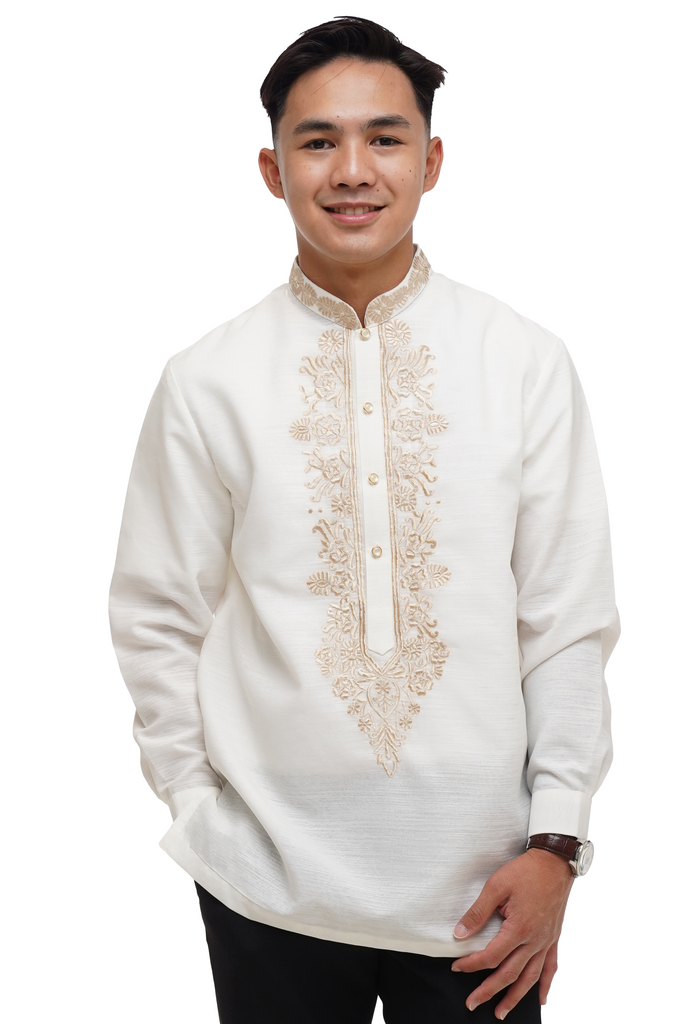Facts About Barong Tagalog Shirt Uncovered
Table of ContentsIndicators on Polo Barongs You Should KnowFacts About Barong Tagalog UncoveredUnknown Facts About Polo Barongs

The term is generally not taken advantage of.
Rather, the name was coined to distinguish the gown as indigenous (hence "tagalog", i. e. ), in contrast to the styles of gown of Europeans and other foreign cultures. Summary [modify] Barong tagalog worn with a salakot. The female is wearing a. Barong tagalog is an official shirt normally made from sheer lightweight however rigid fabric known as (typically woven from pia or abac fibers).
Barong tagalog can differ substantially in regards to layout and also material used, yet they share usual attributes of having long sleeves, needlework, being buttoned (midway or straight down the chest), and the lack of pockets. They are also used loosely and also have slits on both sides. Historically, the product utilized for barong tagalog depended on the social course of the wearer and the formality of the event.
Where To Buy Barong Tagalog Near Me - An Overview

The high quality of the material and the complexity of the needlework were frequently indicators of the standing and also wide range of the user. The needlework of the barong tagalog are generally positioned on a rectangular section on the front of the breast (referred to as pechera, "t shirt front", from Spanish pecho, "upper body"), and/or over the entire t-shirt (sabog, from Tagalog for "spread"). this hyperlink.
They can additionally have other type of embellishment, like alforza (pleats), suksuk (weft floats), as well as also hand-painted styles - custom barong tagalog. Occasionally feminized versions are worn by women, either as an egalitarian or style declaration; or as a form of power clothing when used by female politicians (such as Corazon Aquino throughout her presidency). Amongst Tagalog guys, they were typically paired with a rectangle of highly decorated fabric referred to as the salaual or salawal used knee-length as well as drawn up in the center (like an Indian or Thai as well as Cambodian ); while in females they were coupled with a wraparound skirt known as the.
Nevertheless, in the Visayas, apart from similar baro (which official site had much shorter sleeves) and salaual combinations, guys also wore vivid robe-like and also coat-like variations that might reach well listed below the knees (called the marlota and also baquero in Spanish, respectively). These were occasionally belted at the midsection. Among Tagalogs, red dyes and gold trimmings were a sign of being a member of nobility () or the warrior caste () - view.

Rumored Buzz on Barong Tagalog Dress
The couturier Jose "Pitoy" Moreno has assumed that this transitional style of t shirt was the camisa de chino of later centuries, which makes it a forerunner to the barong tagalog. Representations of members of the top classes (including natives and also) in the 18th century showed that they invariably wore European-style apparel. Visit Your URL.
These were a lot longer than the modern-day barong tagalog, reaching down to slightly above the knees. They were additionally commonly candy striped with vibrant colors like blue, red, or environment-friendly. They currently displayed hallmarks of the modern barong tagalog, including being made of large nipis product, embroidery, lengthy sleeves, as well as a loosened shape with slits on both sides.
Early examples of barong mahaba normally had high-standing collars or also Elizabethan-style ruffs with slim cravats. Barong mahaba were generally put on with colorful straight-cut trousers with red stripes, checkers, or plaid-like patterns (typically made from imported cambaya, rayadillo, and guingn materials), top hats (sombrero de copa), and also a type of embroidered velvet or leather slip-on shoes known as corchos. The large material used by barong mahaba additionally required the using of an undershirt, referred to as camisn or camiseta, which was additionally used on its own by commoners. By the 1840s, barong mahaba greatly befalled of fashion. In this period, it evolved right into the modern "traditional" barong tagalog, being much shorter with less ostentatious folded up collars, while still preserving the sheer fabric as well as other baro features.